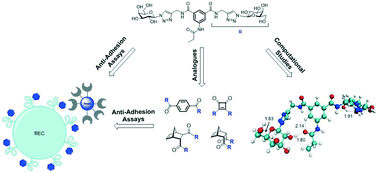Scaffold diversity for enhanced activity of glycosylated inhibitors of fungal adhesion†
Abstract
Candida albicans is one of the most prevalent fungal pathogens involved in hospital acquired infections. It binds to glycans at the surface of epithelial cells and initiates infection. This process can be blocked by synthetic carbohydrates that mimic the structure of cell surface glycans. Herein we report the evaluation of a series of divalent glycosides featuring aromatic (benzene, squaramide) and bicyclic aliphatic (norbornene) scaffolds, with the latter being the first examples of their kind as small molecule anti-adhesion glycoconjugates. Galactosides 1 and 6, built on an aromatic core, were most efficient inhibitors of adhesion of C. albicans to buccal epithelial cells, displacing up to 36% and 48%, respectively, of yeast already attached to epithelial cells at 138 μM. Remarkably, cis-endo-norbornene 21 performed comparably to benzene-core derivatives. Conformational analysis reveals a preference for compounds 1 and 21 to adopt folded conformations. These results highlight the potential of norbornenes as a new class of aliphatic scaffolds for the synthesis of anti-adhesion compounds.



 Please wait while we load your content...
Please wait while we load your content...